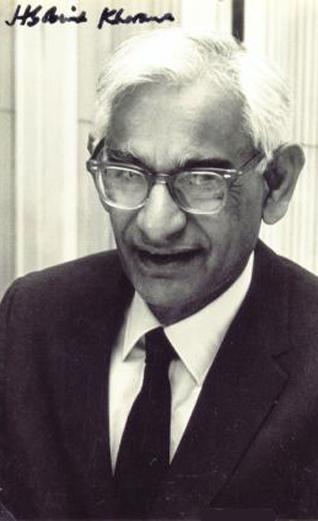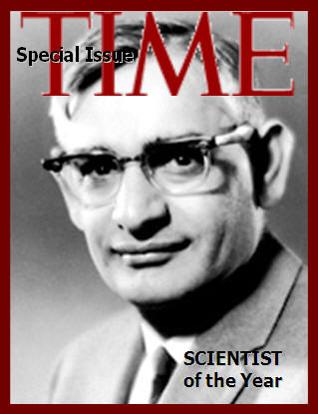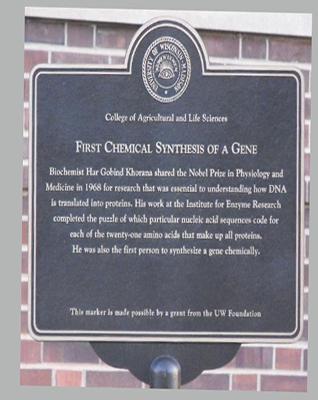People
Har Gobind Khorana [1922-2011]:
Punjab's Nobel Laureate
BIO
Punjab-born Har Gobind Khorana, winner of the 1968 Nobel Prize in Physiology or Medicine, died of natural causes in Concord, Massachusetts, U.S.A. on the morning of Wednesday, November 10, 2011.
He was 89.
Khorana was Alfred P. Sloan Professor of Biology and Chemistry emeritus at Massachusetts Institute of Technology (MIT).
“Gobind was a brilliant, path-breaking scientist, a wise and considerate colleague, and a dear friend to many of us at MIT,” said Chris Kaiser, MacVicar Professor of Biology and head of the Department of Biology, in an email announcing the news to the department’s faculty.
Har Gobind Khorana was born to a sehajdhari family in Raipur, a little village in the part of Punjab which is now part of Pakistan.
The correct date of his birth is not known, as per the biographical notes with the Nobel Foundation, though that shown in documents is January 9th, 1922.
Khorana devoted much of his scientific career to unravelling the genetic code and the mechanisms by which nucleic acids give rise to proteins.
He was the youngest of a family of one daughter and four sons. His father was a patwari, a village agricultural taxation clerk in the British Indian system of government.
In an autobiographical note written upon winning the Nobel Prize, Khorana wrote: “Although poor, my father was dedicated to educating his children and we were practically the only literate family in the village inhabited by about 100 people.”
Khorana attended D.A.V. High School in Multan (now in Pakistan) and then went on to study at the Punjab University in Lahore where he obtained an M.Sc. degree. He lived in India until 1945, when the award of a Government of India Fellowship made it possible for him to go to England where he studied for a Ph. D. degree at the University of Liverpool. He spent a postdoctoral year (1948-1949) at the Eidgenössische Technische Hochschule in Zurich with Professor Vladimir Prelog.
The association with Professor Prelog, he said, moulded his thought and philosophy towards science, work, and effort immeasurably.
It was in Switzerland itself that he met his wife, the late Esther Elizabeth Sibler, whom he married in 1952.
As he later wrote: “Esther brought a consistent sense of purpose in my life at a time when, after six years’ absence from the country of my birth, I felt out of place everywhere and at home nowhere.”
After a brief period in India in the fall of 1949, Khorana returned to England where he obtained a fellowship at Cambridge where he stayed from 1950 till 1952. This is where his interest in both proteins and nucleic acids took root.
A job offer in 1952 from The British Columbia Research Council in Vancouver took him to Canada, and that is where he settled down with his wife, raising three children: Julia Elizabeth (born May 4th, 1953), Emily Anne (born October 18th, 1954), and Dave Roy (born July 26th, 1958).
The MIT News Office quotes his colleague Uttam Rajbhandary, MIT’s Lester Wolfe Professor of Molecular Biology, recalling Khorana’s telling of how he accepted the position: “Gobind was so excited that he was going to start a lab of his own. He looked at the map of Canada, saw where Vancouver was for the first time, and off he went,”
In 1960, Khorana moved to the Institute for Enzyme Research at the University of Wisconsin. This is where he and his colleagues worked out the mechanisms by which showed how the nucleotides in nucleic acids, which carry the genetic code of the cell, control the cell’s synthesis of proteins, leading to the Nobel Prize in 1968, which he shared with Robert Holley of Cornell University and Marshall Nirenberg of the National Institutes of Health.
Khorana confirmed Nirenberg’s findings that the way the four different types of nucleotides are arranged on the spiral “staircase” of the DNA molecule determines the chemical composition and function of a new cell. The 64 possible combinations of the nucleotides are read off along a strand of DNA as required to produce the desired amino acids, which are the building blocks of proteins.
Khorana added details about which serial combinations of nucleotides form which specific amino acids. He also proved that the nucleotide code is always transmitted to the cell in groups of three, called codons. Khorana also determined that some of the codons prompt the cell to start or stop the manufacture of proteins.
In between, he became a naturalized citizen of the United States in 1966.
As of the fall of 1970 Khorana had been Alfred P. Sloan Professor of Biology and Chemistry at the Massachusetts Institute of Technology, where he continued at the forefront of the ballooning field of genetics.
Shortly after arriving at MIT, Khorana - along with colleagues - announced the synthesis of two different genes crucial to protein building. In a major breakthrough in 1976, he and his research team were able to synthesize the first artificial copy of a yeast gene - the first fully functional man-made gene in a living cell. This method of chemically synthesizing genes made possible controlled, systematic studies of how genetic structure influences function.
Khorana then became interested in other cellular components, including biomembranes and, in the visual system, rhodopsin - the pigment on the eye’s retina that is responsible for the first step in the biological perception of light.
His later research explored the molecular mechanisms underlying the cell signalling pathways of vision in vertebrates.
His studies were concerned primarily with the structure and function of rhodopsin, a light-sensitive protein found in the retina of the vertebrate eye.
Khorana also investigated mutations in rhodopsin that are associated with retinitis pigmentosa, which causes night blindness.
He retired from the MIT faculty in 2007.
“Even while doing all this research, he was always really interested in education, in students and young people,” his daughter Julia Khorana said. “After he retired, students would come to visit and he loved to talk to them about the work they were doing. He was very loyal to them, and they were very loyal to him, too.”
Prof. Rajbhandary says he will remember Khorana for his drive and focus, but also his humility. “As good as he was, he was one of the most modest people I have known,” he says. “What he accomplished in his life, coming from where he did, is truly incredible.”
In addition to the Nobel, Khorana won many other professional awards, including the Louisa Gross Horwitz Prize from Columbia University and the Lasker Foundation Award for Basic Medical Research, both in 1968; the Willard Gibbs Medal of the Chicago section of the American Chemical Society, in 1974; the Gairdner Foundation Annual Award, in 1980; and the Paul Kayser International Award of Merit in Retina Research, in 1987. He was a member of the National Academy of Sciences
and a fellow of the American Academy of Arts and Sciences, among other distinguished professional memberships.
Khorana is survived by his daughter, Julia, and son, Dave.
[Biographical details: courtesy, The Nobel Foundation, Britannica.com, Wikipedia and Emily Finn of MIT News. Edited for sikhchic.com]
November 13, 2011
Conversation about this article
1: Aown (Lahore, Punjab, Pakistan), November 13, 2011, 1:16 PM.
May God bless the soul of this great man.
2: A.J. Singh (San Francisco, California, U.S.A.), November 13, 2011, 1:16 PM.
A great loss indeed, but humanity will forever be indebted to his research on DNA and our genetic code. I remember growing up on the stories of Dr. Khorana and how the mere mention of his name would bring a huge smile on my grandfather's face.
3: Sangat Singh (Kuala Lumpur, Malaysia), November 13, 2011, 4:06 PM.
Soon after Har Gobind Khorana won the Noble Prize, he was promptly re-adopted as a great son of India. R.X Laxman, the famous cartoonist came up with the topical cartoon showing a big crowd waiting to get Har Gobind's autographs. Laxman's comment was: "Why such a fuss, why don't we dig his old application for a job that we rejected. It has his signature on it!"
4: Harinder (Uttar Pradesh, India), November 13, 2011, 8:26 PM.
We need now the Gen Next to get some Nobels into our community's kitty. Gear up, boys and girls, the Goal Post is there to shoot at.
5: Devinder Singh (India), November 13, 2011, 9:56 PM.
Sangat Singh ji; that is how destiny works. In India, he would never have been able to research the Gene.
6: Gurinder Singh (Stockton, California, U.S.A.), November 13, 2011, 11:47 PM.
When he was awarded the Nobel Prize, there was great rejoicing in Punjab and India. He visited Patiala where his family had settled after Partition. It is true that he did not get employment in India after completing his M.Sc.
7: Charanjit Singh (Pinjore, Punjab), November 14, 2011, 11:50 AM.
Dr. Har Gobind Khorana, born in "Lehanda" Punjab, belonged both to Pakistan as well as India. He won the Nobel Prize and many laurels in distant lands. But none of these two governments ever thought of honouring him. I think the media of both these two countries should take the lead to take up the issue of awarding this great son of undivided Punjab.
8: Vinod Kumar (Kurnool, Andhra Pradesh, India), October 30, 2014, 10:59 AM.
He is indeed a highly talented person.





